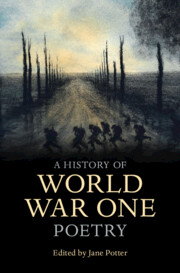Book contents
- A History of World War One Poetry
- A History of World War One Poetry
- Copyright page
- Dedication
- Contents
- Illustrations
- Contributors
- Acknowledgements
- Introduction
- Part I Literary Contexts
- Part II Nations and Voices
- Part III Poets
- Chapter 20 Non-Combatants
- Chapter 21 Edward Thomas (1878–1917)
- Chapter 22 Guillaume Apollinaire (1880–1918)
- Chapter 23 Siegfried Sassoon (1886–1967) and Edmund Blunden (1896–1974)
- Chapter 24 Anna Akhmatova (1889–1966)
- Chapter 25 Mary Borden (1886–1968)
- Chapter 26 Georg Trakl (1887–1914)
- Chapter 27 Isaac Rosenberg (1890–1918)
- Chapter 28 Ivor Gurney (1890–1937)
- Chapter 29 Wilfred Owen (1893–1918)
- Chapter 30 David Jones (1895–1974)
- Part IV
- Bibliography
- Index
Chapter 23 - Siegfried Sassoon (1886–1967) and Edmund Blunden (1896–1974)
from Part III - Poets
Published online by Cambridge University Press: 18 January 2023
- A History of World War One Poetry
- A History of World War One Poetry
- Copyright page
- Dedication
- Contents
- Illustrations
- Contributors
- Acknowledgements
- Introduction
- Part I Literary Contexts
- Part II Nations and Voices
- Part III Poets
- Chapter 20 Non-Combatants
- Chapter 21 Edward Thomas (1878–1917)
- Chapter 22 Guillaume Apollinaire (1880–1918)
- Chapter 23 Siegfried Sassoon (1886–1967) and Edmund Blunden (1896–1974)
- Chapter 24 Anna Akhmatova (1889–1966)
- Chapter 25 Mary Borden (1886–1968)
- Chapter 26 Georg Trakl (1887–1914)
- Chapter 27 Isaac Rosenberg (1890–1918)
- Chapter 28 Ivor Gurney (1890–1937)
- Chapter 29 Wilfred Owen (1893–1918)
- Chapter 30 David Jones (1895–1974)
- Part IV
- Bibliography
- Index
Summary
Siegfried Sassoon and Edmund Blunden both saw action and survived into the late twentieth century as successful men of letters whose styles were quite different. This chapter looks at their literary friendship and compares their work, clarifying where they stand in relation to the Georgians and other war poets, while putting them in a broader cultural perspective. It shows how experience of the trenches led them to twist traditional forms, and examines the stylistic and personal challenges they faced as survivors, their writings ever more retrospective. It argues that Blunden’s complexpoetry may feel archaic but has Modernist elements and has been unjustly neglected by comparison with Sassoon’s more accessible but less subtle verse. With close analysis and comparison, and some redefining of key texts, the chapter emphasises their contrasting approaches: Blunden the troubled pastoralist, exploring profounder shades of meaning; Sassoon deliberately ‘anti-poetic’, but with satirical designs on us.
- Type
- Chapter
- Information
- A History of World War One Poetry , pp. 379 - 391Publisher: Cambridge University PressPrint publication year: 2023

